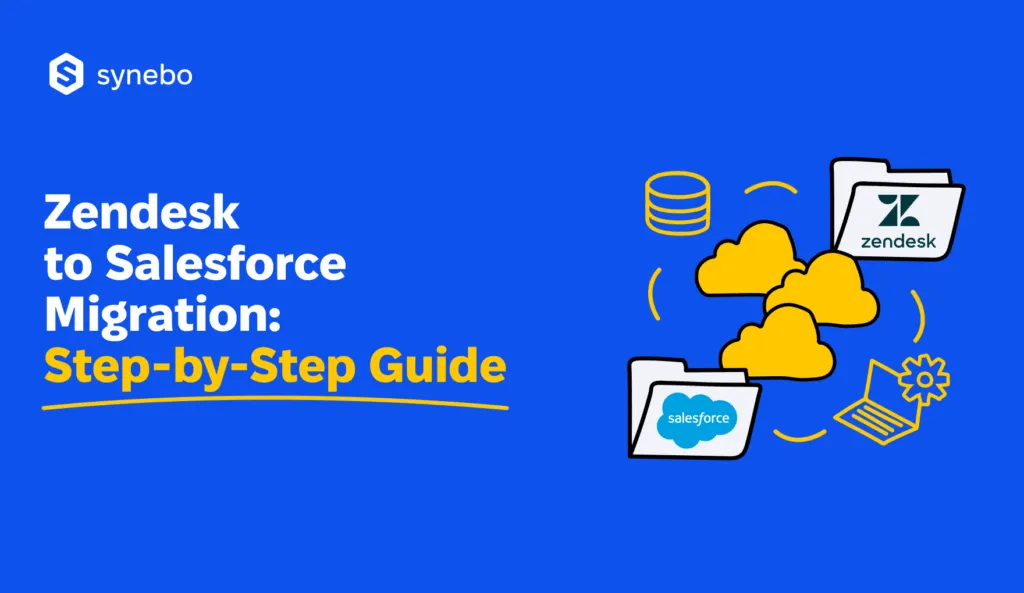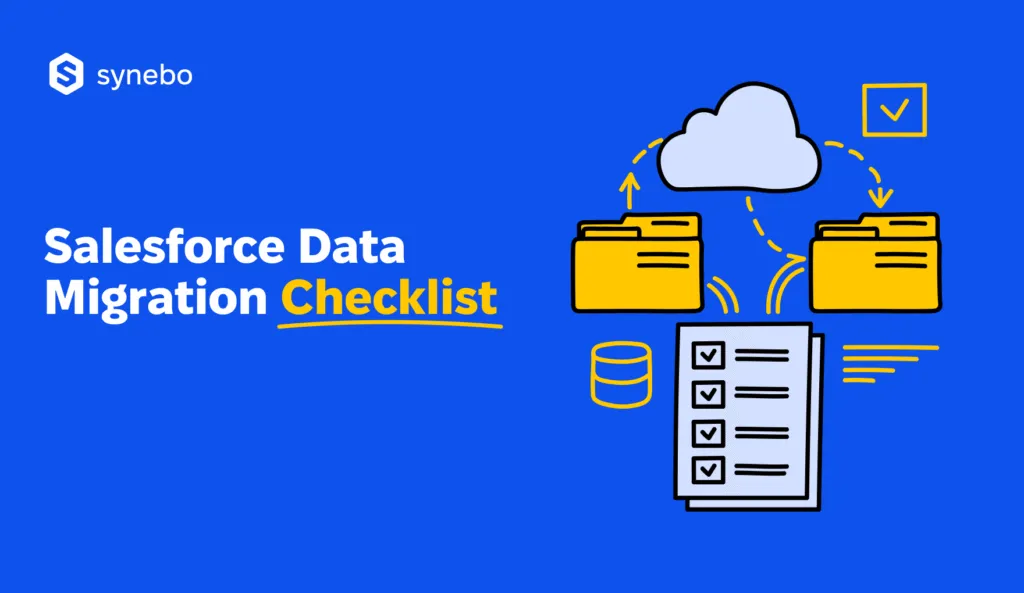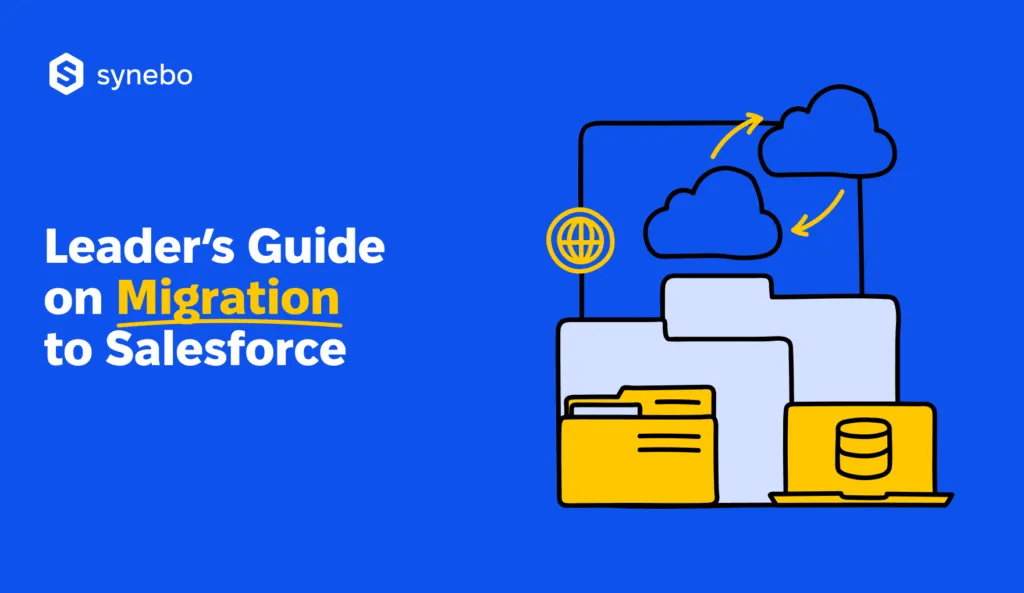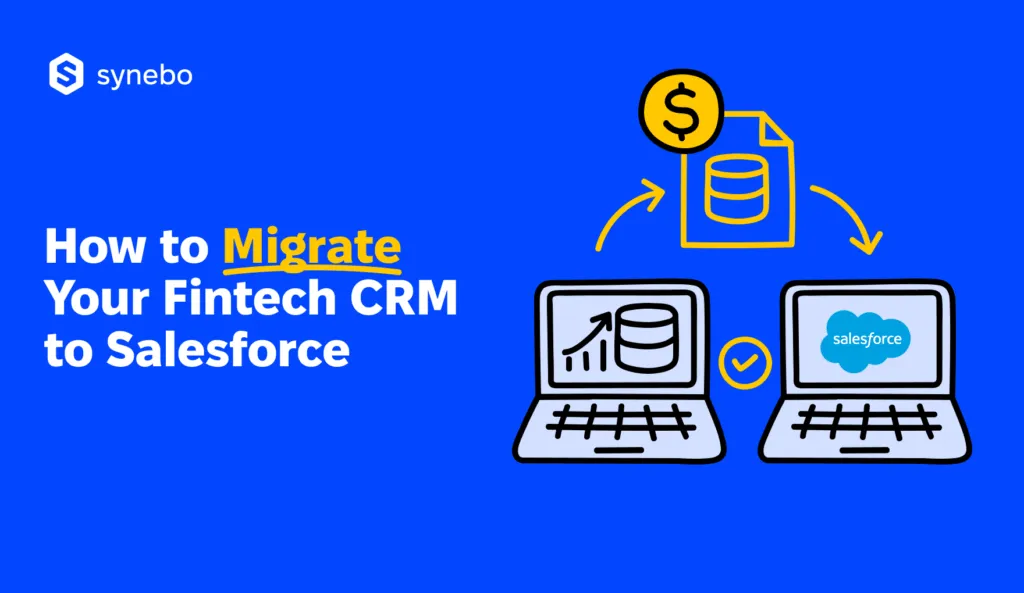Pros & Cons of Moving from Zendesk to Salesforce Service Cloud
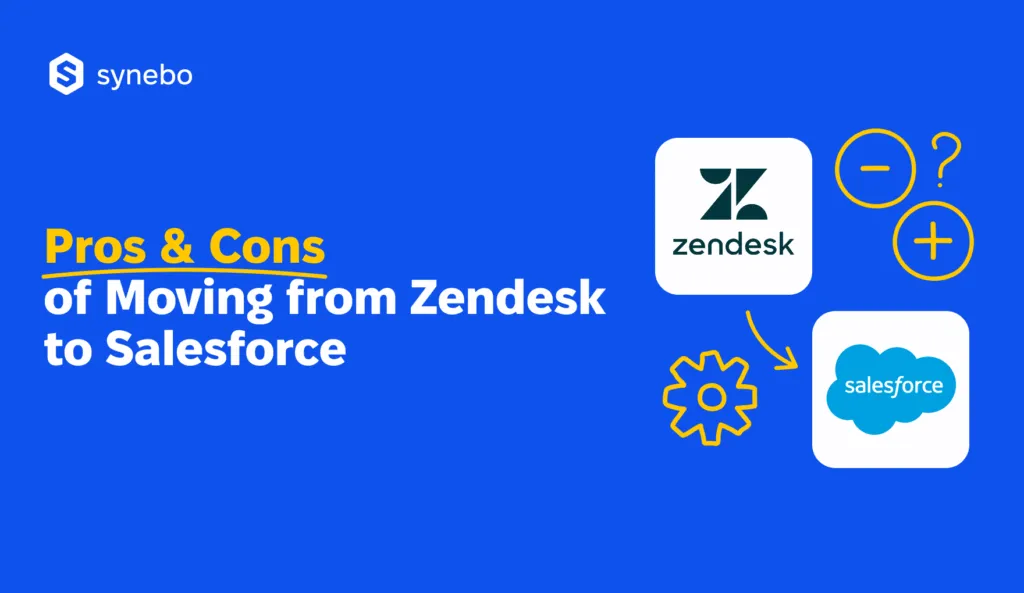
When your support team crashes under ticket overload and siloed tools groan under demand, you start weighing your options. And migrating from Zendesk to Salesforce may be one of them.
Many businesses often advance beyond Zendesk’s simplicity when they need more enterprise-wide cohesion. You – too – may now be seeking a customer platform that ties support, commercial, marketing, and data units together. Your appeal is, most probably, deeper integration for your Depts. You may also need richer visibility into your client journeys, history, and interactions. Plus, the ability to sync workflows with your full ecosystem.
Meanwhile, as experienced Salesforce data migration consultants, we know that any switch isn’t carefree. Leaders usually want to weigh the complexity of the leap, the higher investment, the need for upskilling, and the risk of disruption during migration and adjustment periods (very low when done right, though).
Still, the upside of your migration to Salesforce can prove truly powerful. Stats say, companies that move from Zendesk to SF see help desk ROI boost by more than a third (34%), plus a significant drop in support costs (by 26%).
In the following sections, we’ll make a Zendesk vs Salesforce comparison, explore why migrate from Zendesk to Salesforce – what practical outcomes it brings, and where decision-makers should tread carefully before swapping platforms.
Face-to-Face: Salesforce vs Zendesk Comparison
When executives feel that various touchpoints of their clients vanish into scattered data, their frustration grows quickly. You may feel it, too.
Zendesk, recognized for its clean ticketing, often serves companies well at the start. Yet, as your business matures, your leaders may crave something bigger. We’ve persistently heard from our clients that they want an environment where support doesn’t stand alone. It has to interlock with promotions, sales, and financial operations.
Looking ahead, we can spoiler that after migrating to Salesforce, you get all of this.
But before moving on, let’s take a closer look at Zendesk and note 3 of its strengths. For the picture’s completeness, we can also note 3 strong points of SF (its Service Cloud).
So, how does Zendesk compare to Salesforce Service Cloud?
What Zendesk’s is good at:
- Simplicity. Yes, it offers a quick setup, easy UI, and understandable reporting.
- Speed. True: it boasts fast deployment and adoption by client care crews.
- Focus. Absolutely. It has a strong emphasis on ticket resolution and care of customers.
Meanwhile, when moving from Zendesk to Salesforce Service Cloud, you gain the following strengths:
- Integration. Your help desk service becomes an integral part of the same ecosystem as customer management, marketing, and data analytics.
- Advanced capabilities. For example, SF AI-driven case routing, automations, and management of knowledge base. They expand far beyond what Zendesk can offer.
- Scalability. SF (Service Cloud, in particular) is initially built for companies that seek one customer platform for every Dept.
Overall, as one of our clients once said, “The difference between Zendesk and Salesforce feels like moving from a well-equipped apartment to an interconnected smart campus. One keeps daily tasks manageable, the other builds an infrastructure for growth. It involves my whole business”.
And this is true. Zendesk performs admirably as a reliable service desk. Salesforce Service Cloud offers strikingly more when you want responsive support and a connected strategy for your business. We’d suggest that you approach Salesforce migration not as if you abandon Zendesk’s strengths.
It’s more about turning your help desk service from a standalone function into a driver for loyalty, money, and scaling your whole business.
Signals It’s Time to Look Beyond Zendesk
You may probably confirm our words: the tipping point never happens overnight. It often creeps gradually in. First – through dashboards that take forever to load. Then – through your people who start juggling many browser tabs. Eventually – through your managers being frustrated with incomplete info or misleading analytics (“The system says so, but it makes no sense”).
However, at this stage, the question “Salesforce or Zendesk – which CRM is better for my business?” is usually still too early to ask. You just progressively start seeing that what once felt comfortable on Zendesk, now doesn’t function well. The platform strains under rising complexity.
The main driver to migrate from Zendesk to Salesforce is usually a combo of the reasons, which have already accumulated and block you from working smoothly:
- Heavy ticket load. A surge in inquiries slows your help desk crew and limits response consistency.
- Data you can’t count on (fragmented, incomplete, or repeated). Your commercial, marketing, and client support Depts – each operate in separate realities. It leaves your executives without a whole picture of your customers.
- Noticeable gaps in reporting. Your key people crave deeper analytics, yet the system struggles to provide it.
- Use of many add-ons. You have to install multiple extensions to cover missing functionality (and it often increases your costs + complicates maintenance).
- Your agents are stressed. Constant tab-switching across tools drains their focus, lowers morale, and results in fatigue.
- No executive lens. Your COO, CMO, CHRO, CIO, and others want – surely – efficiency. That’s why they seek to turn customer data into a shared source for sales, marketing, and forecasting.
These signs don’t mean Zendesk is bad. No, it continues to be reliable – good enough – for many teams.
Yet when you push for scale, Salesforce CRM migration becomes indispensable. Why? Because the SF Service Cloud naturally becomes your hub where your customer info converges. Plus, its dashboards respond swiftly, and insights stretch beyond support into every corner of your enterprise.
Our experience shows that for many ambitious companies, a broader view often outweighs staying with “good enough.”
Spot any of these patterns in your daily work? At Synebo, we help companies migrate from Zendesk to Salesforce painlessly, without breaking daily operations. Reach out to our team if you need advice on whether the moment has come to move.
Salesforce vs Zendesk: Your Gains of Moving to SF
We’ve uncovered the frustrations that drive the switch. Now, what’s on the winning side for companies after the Zendesk to Salesforce migration?
Let’s lay it out clearly.
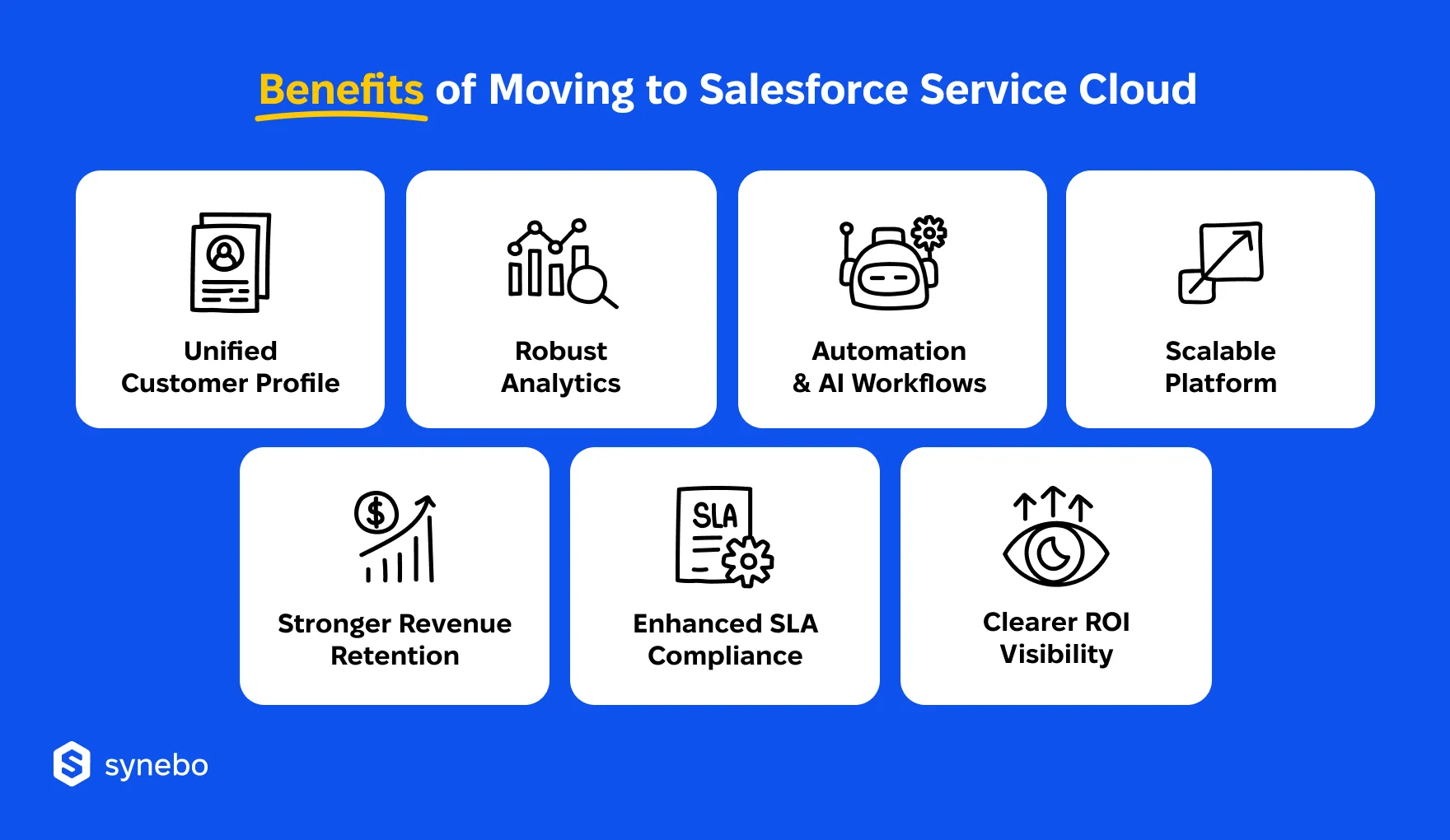
So, executives frequently point to these benefits of Zendesk to Salesforce Service Cloud migration:
- Unified profiles. All your Depts (commercial, customer support, and marketing) work from the same customer record. Such a profile reduces duplicate data and blind spots.
- Really impressive analytics. You can use dashboards (they are adapted for both executives and managers) and they reveal patterns that repeat, and forecasts and don’t demand manual reporting.
- Automation and overall workflows. Your help desk crew may relax (we’re surely kidding here). Seriously speaking, intelligent routing, macros, and robust AI tools help them answer consistently and considerably cut their response times.
- Scalability. You see the number of inquiries growing? Fine – SF expands smoothly with you. And demands no multiple add-ons.
The outcomes of Zendesk to Salesforce data migration that matter for leadership:
- Stronger revenue retention. When your Depts see exhaustive info about customers and resolve issues with more context, your clients feel understood and valued. That drives their loyalty and protects your monthly recurring revenue.
- Enhanced SLA observance. With SF, automated workflows trасk the time of your response to clients and issue resolution. So, you don’t rely on manual follow-ups. You gain confidence that your service commitments are consistently honored.
- Clearer understanding of ROI. Leaders of your company can trace how every CX investment connects to the business outcomes. They work not from guesswork, but from hard numbers.
So, when you look at Salesforce Service Cloud vs Zendesk, they have a strategic difference: Zendesk helps with your service. But Service Cloud gives your help desk service a bigger реrspective. It turns your customers’ stronger loyalty into an absolutely measurable revenue growth.
Zendesk CRM vs Salesforce: “Cons” You Have to Weigh
Every upgrade may carry trade-offs. And when you migrate from Zendesk to Salesforce Service Сloud, it’s essential to understand your risks, too.
We have already discussed advantages (and they are compelling). Yet, if you are thinking about the switch, these few possible hurdles surely deserve your attention.
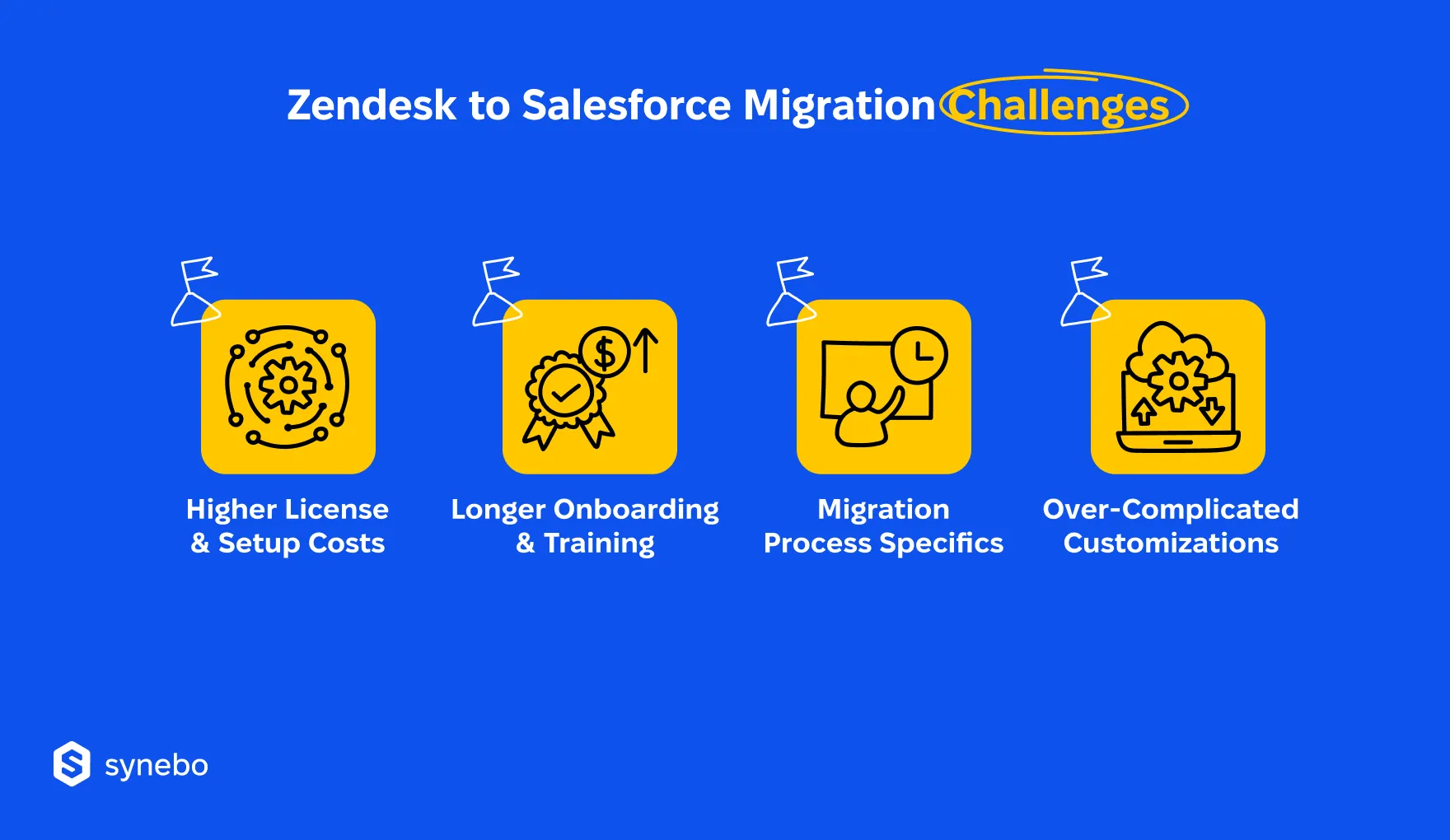
So, Zendesk vs Salesforce – what are the “cons” you should factor in?
- License and setup costs. Salesforce usually brings a larger price tag. If you are an enterprise and want advanced modules – in particular.
- Migration рrocess itself. When you migrate to Salesforce and shift accumulated data, workflows you are accustomed to, and ingrained habits, it really requires planning and patience.
- Time for learning. You will need more time for onboarding and training of your people compared with Zendesk’s simplicity.
- Customization overload. After Zendesk’s ease, SF’s wide scope of tailoring may seem excessive. Without governance, some companies switching from Zendesk to Salesforce layer too much customization. This risks turning the whole switch into a challenge.
These points don’t cancel out the benefits of your data migration to Salesforce. They merely highlight why preparation matters.
Read Also: “Salesforce Data Migration Checklist: What to Prepare Before You Start”
Companies that invest in structured onboarding and governance usually go through the transition more smoothly. When/if you are weighing Zendesk or Salesforce, we advise that you recognize: while the first offers convenience today, Service Cloud opens a more expansive path tomorrow. Although it demands upfront resources and discipline to execute well.
Thinking about migrating to SF but unsure how to balance the upsides vs the downsides? As a Salesforce data migration partner, we helped many companies with taking this decision. Let’s discuss how to make your transition stress-free.
Is the Time Right to Step Up from Zendesk?
As you could see above, choosing the right moment to move from Zendesk is about signals. We’ve prepared this checklist to help you spot those signals more clearly.
Zendesk vs Salesforce Service Cloud Migration: Checklist if It’s Time
☐ Support volume has outgrown Zendesk. Agents drown in overflowing queues. Customers feel the slowdown.
☐ Customer data is fragmented across Depts. Its full view is out of reach.
☐ Current dashboards don’t give your executives relevant info. KPIs and forecasts don’t reflect the truth. Making decisions is hard.
☐ Spending on integrations/expentions keeps climbing. Yet the functionality of your system still falls short of your expectations/needs.
☐ Audit trails, controls based on roles, and residency of data need strong(-er) support. Рroblems with сompliance and security keep increasing.
☐ You’ve got growth ambitions. Entering new markets, launching products, or adding service channels will demand a more adaptable platform.
☐ Your help desk agent morale and customer experience are declining. Your team is frustrated, and together with inconsistent service, this all hints that tools are holding your business back.
If you’ve ticked 3 or more of these boxes, you got signals of a serious need to explore the SF Service Cloud.
With the expert Salesforce data migration services, planning your move to the next level won’t be disruptive. It can be the first step toward a system that favors your growth.
Stepping Into a Broader Horizon
So, Salesforce and Zendesk are both perfect options – each at its level. And when Zendesk starts feeling tight and fragmented, you may already know that your client care service is ready to grow and is just doing it.
When moving from Zendesk to Salesforce Service Cloud, you create a unified space where sales, marketing, and support “meet and live” together, dashboards respond promptly, and automations help your people interact much better with your customers. And you grow as a business, free from problems with your CRM.
The transition process itself can be scary or daunting – it’s true. Partner with a skillful Salesforce data migration service provider – and your switch will go painlessly. Synebo helps companies cope with the migration challenges, optimizes workflows, and ensures employees adopt the platform fast and successfully. Our approach balances strategy, technology, and execution.
Our experts will help you enjoy the benefits of the move, and you’ll avoid getting lost in complexity.
Contact Synebo to start planning your Zendesk to Salesforce migration. And see how your client care service evolves into a fully connected, growth-driven engine.
Many companies outgrow Zendesk – they see that help desk, commercial, and marketing Depts begin pulling in separate directions. Salesforce Service Cloud creates one shared environment where you have the whole customer story. With richer automation, cross-team visibility, and really strong analytics, Service Cloud efficiently supports the ambitions and aspirations of your business.
Zendesk’s origins lie in ticket management. It’s still good at straightforward support tasks. SF Service Cloud, by contrast, integrates support into a much broader context where your customer is a central figure. It connects cases with leads, opportunities, and campaigns. This all makes SF bigger than just a service tool. It becomes a vital component of your business engine.
“Better” is conditioned by your horizon. For not big teams focused on ease of use and hassle-free setup, Zendesk performs well. Salesforce beats when complexity rises: international operations, multiple Depts, а need to follow compliance rules, or growth into new markets. In these contexts, SF doesn’t compete with Zendesk. It consolidates separate systems into one and makes it more powerful.
Timelines vary indeed. Small deployments with modest data often finish within 4–8 weeks. Enterprise migrations may extend to 3–6 months. As for expenses, they typically include SF licenses, possible add-ons that you will use, and the services of migration experts.
A migration can cover tickets (sure), customer records, organizations, custom fields, attachments, tags, and even knowledge articles. Which data you relocate is determined by your goals, priorities, and needs. Some firms focus only on recent activity. Others import history in full. Mind please that the scope matters because cleaner, well-organized information makes SF more effective.


